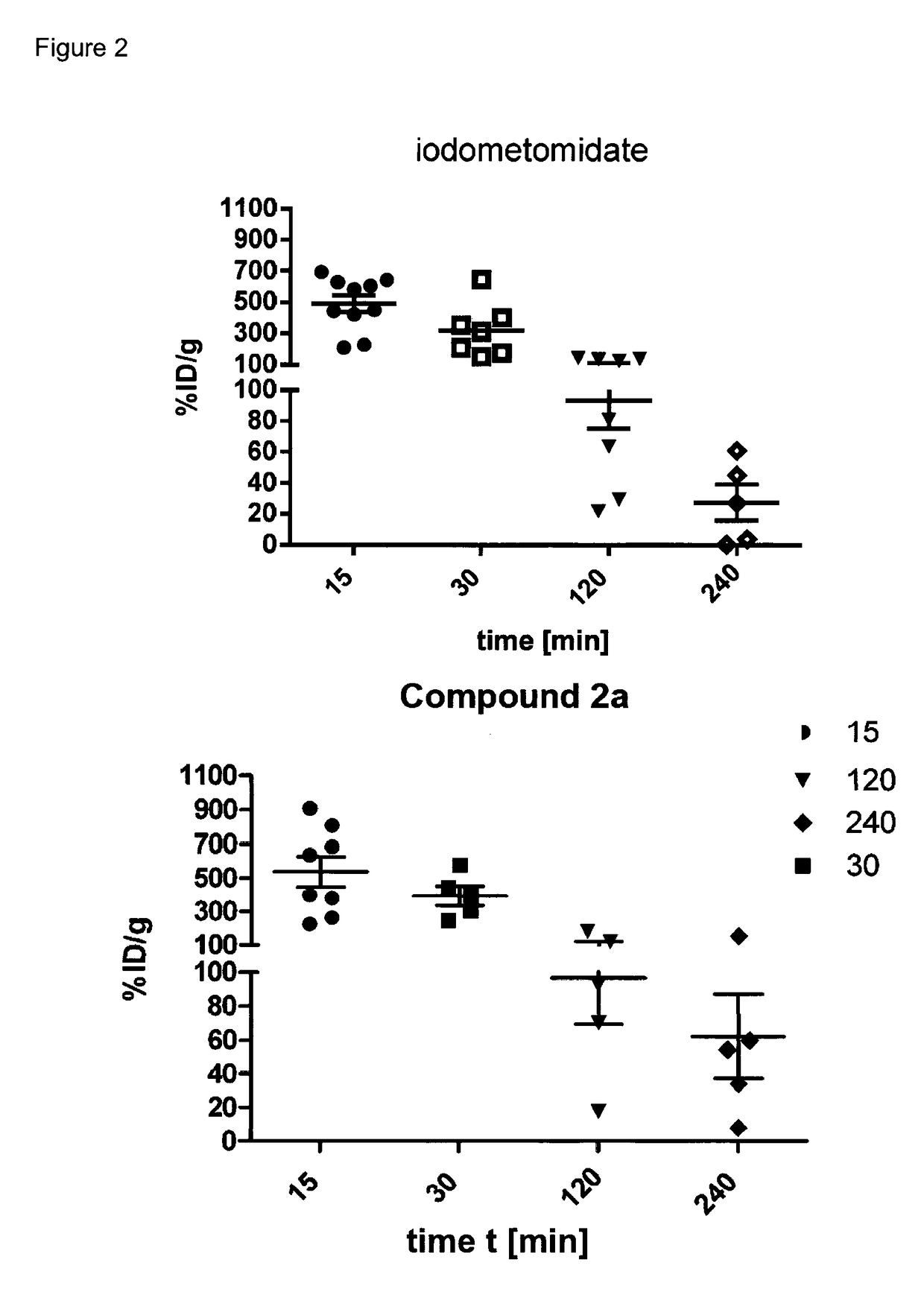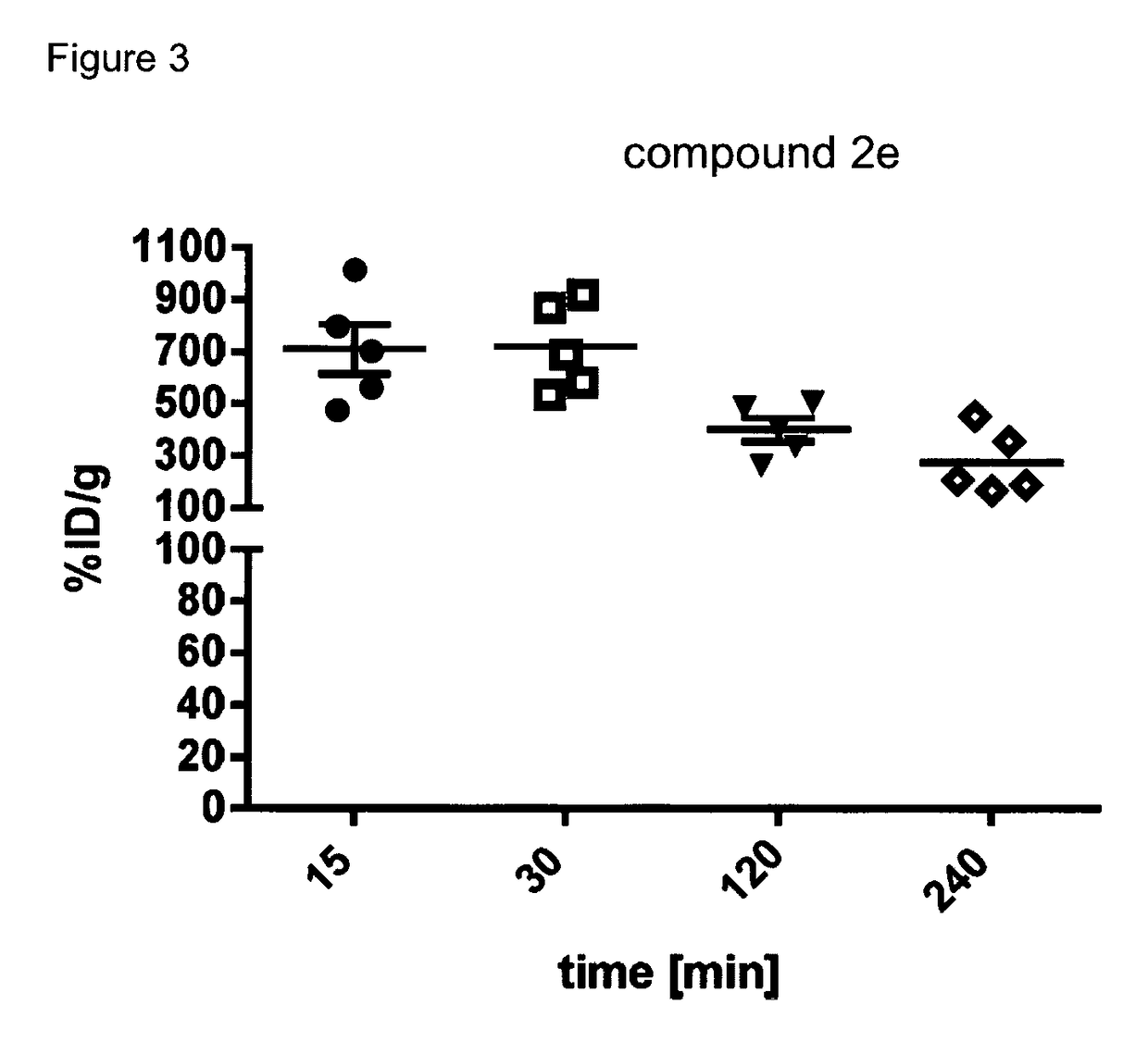Radiopharmaceutical products for diagnosis and therapy of adrenal carcinoma
a radiopharmaceutical and adrenal carcinoma technology, applied in the direction of antineoplastic agents, organic active ingredients, drug compositions, etc., can solve the problems of difficult laboratory diagnosis, limited information about the origin of adrenal lesion by conventional imaging, and difficult diagnosis of adrenocortical carcinoma, so as to improve metabolic stability, high specificity for tissues, and the effect of improving the uptake of compound
- Summary
- Abstract
- Description
- Claims
- Application Information
AI Technical Summary
Benefits of technology
Problems solved by technology
Method used
Image
Examples
example 1
1. Synthesis of the Non-Radioactive Standard 2a Via 8 Steps
Step 1: R-(+)-1-(4-Iodophenyl)-ethylamine
[0117]
[0118]A solution of 58.6 mL (55.5 g, 458 mmol) R-(+)-1-phenylethylamine in 80 mL 1,2-dichloroethane was cooled in an ice bath, a solution of 80 mL (119 g, 570 mmol) trifluoroacetic acid anhydride in 80 mL 1,2-dichloroethane was added dropwise, and stirring was performed for 90 min at rt. After cooling in an ice bath, 55.5 g (218 mmol) iodine and 100 g (222 mmol) Bis(trifluoracetoxy)iodobenzene were added. The solution was stirred overnight and quenched by 1050 mL of a 10% sodium thiosulfate-solution. After extraction with 1000 mL methylene chloride the organic phase was washed with a saturated solution of sodium bicarbonate and dried over sodium sulfate. The solvent was stripped under reduced pressure and the crude product redissolved in 410 mL of warm diethyl ether and 113 mL hexanes. After cooling in a refrigerator, the product precipitated.
[0119]Melting point: 162-4° C.
[0120]...
example 2
Synthesis of (R)-1-[1-(4-Iodophenyl)ethyl]-1H-imidazole-5-carboxylic acid azetidinylamide (2e)
[0188]
[0189]A solution of 534 μL (558 mg, 4.5 mmol) trimethylphosphite in 24 mL methylene chloride was cooled in an ice bath and was charged with 1.14 g (4.5 mmol) iodine. After complete dissolution of the iodine, 1.55 g (4.5 mmol) (R)-1-[1-(4-iodophenyl)ethyl]-1H-imidazole-5-carboxylic acid and 1.04 mL (759 mg, 7.5 mmol) triethylamine were added. 10 min later, 507 μL (429 mg, 7.5 mmol) azetidine was added and the solution stirred for 3 h at room temperature. The solution was diluted with 100 mL chloroform, washed once with 100 mL of a saturated sodium thiosulfate-solution and three times with each 50 mL water and dried over sodium sulfate. After stripping the solvent, the crude product was purified by column chromatography (CH2Cl2 / CH3OH 95 / 5).
[0190]Product Characteristics:
[0191]Appearance: Yellow waxy solid
[0192]Yield: 770 mg (2.02 mmol, 44.9%)
[0193]Thin-Layer Chromatography (Silica Gel):
[...
example 3
n of Specificity for CYB11B1 and CYP11B2 Inhibition In Vitro
[0218]Plasmid constructs and transfection: To induce expression of human cytochrome P450 family 11B1 (Cyp11B1) and Cyp11B2 enzymes in Y1 cells, the full-length cDNAs for the proteins were subcloned into the multicloning site of pcDNA3.1 (zeo) (Invitrogen, Eggenstein, Germany). The cDNA fragments were isolated by PCR and digested by EcoRI. The individual fragments were ligated into the linearized vectors digested by EcoRI. Human Cyp11B1 and Cyp11B2 enzymes were expressed in Y1 cells using liposome / lipid-mediated DNA transfection. Purified plasmid DNA was mixed with Lipofectamine (Invitrogen) transfection reagents according to the manufacturer's protocol. To generate a stable Y1-Cyp11B1 and Y1-Cyp11B2 cell line, Y1 cells were transfected with the pcDNA3.1 (zeo)-Cyp11B1 and pcDNA3.1 (zeo)-Cyp11B2 vector, respectively.
[0219]Transfected cells were selected with 1000 μg / ml zeocin (Invitrogen). To screen colonies, Western blotting...
PUM
| Property | Measurement | Unit |
|---|---|---|
| volume | aaaaa | aaaaa |
| temperature | aaaaa | aaaaa |
| temperature | aaaaa | aaaaa |
Abstract
Description
Claims
Application Information
 Login to View More
Login to View More - R&D
- Intellectual Property
- Life Sciences
- Materials
- Tech Scout
- Unparalleled Data Quality
- Higher Quality Content
- 60% Fewer Hallucinations
Browse by: Latest US Patents, China's latest patents, Technical Efficacy Thesaurus, Application Domain, Technology Topic, Popular Technical Reports.
© 2025 PatSnap. All rights reserved.Legal|Privacy policy|Modern Slavery Act Transparency Statement|Sitemap|About US| Contact US: help@patsnap.com



